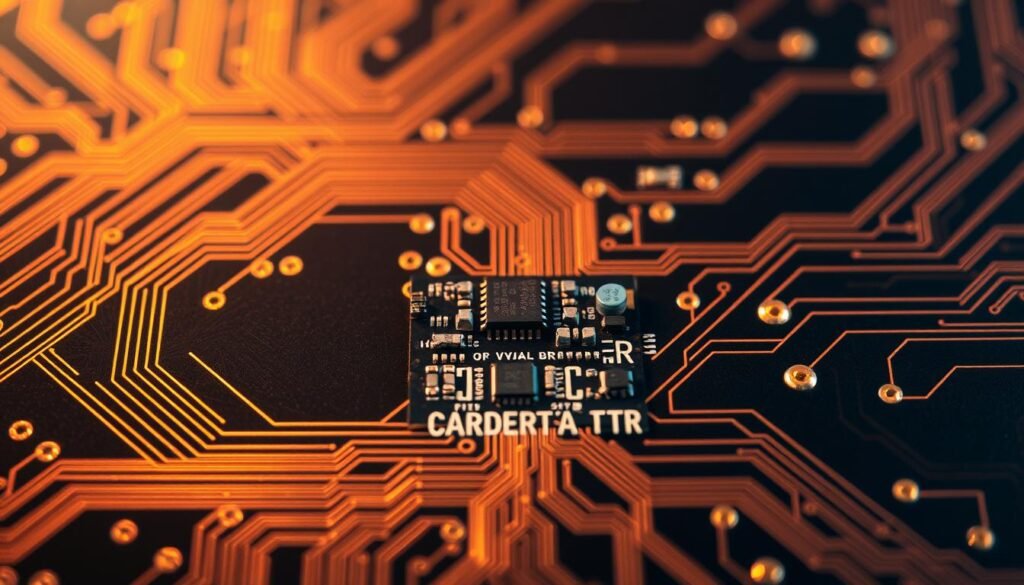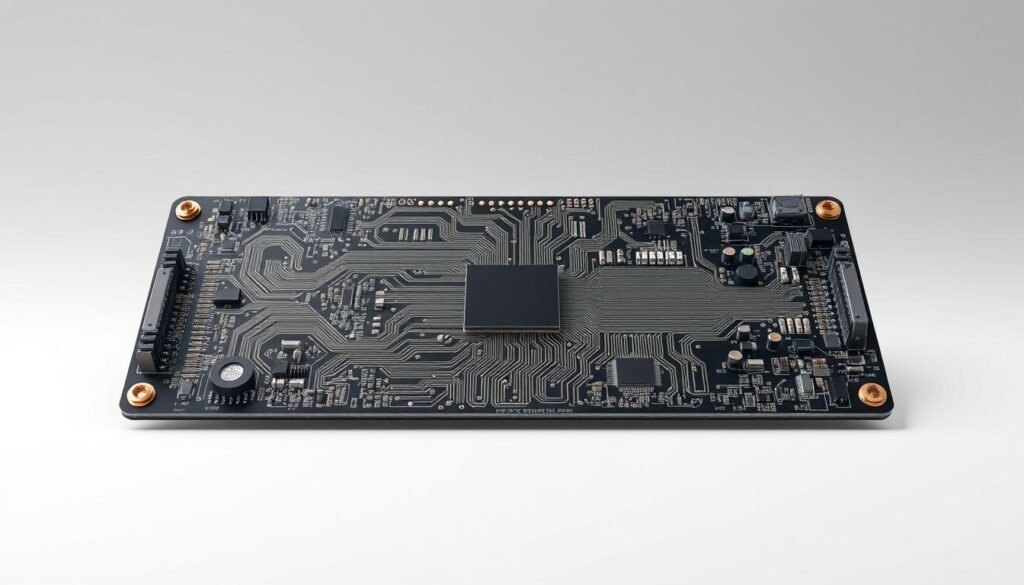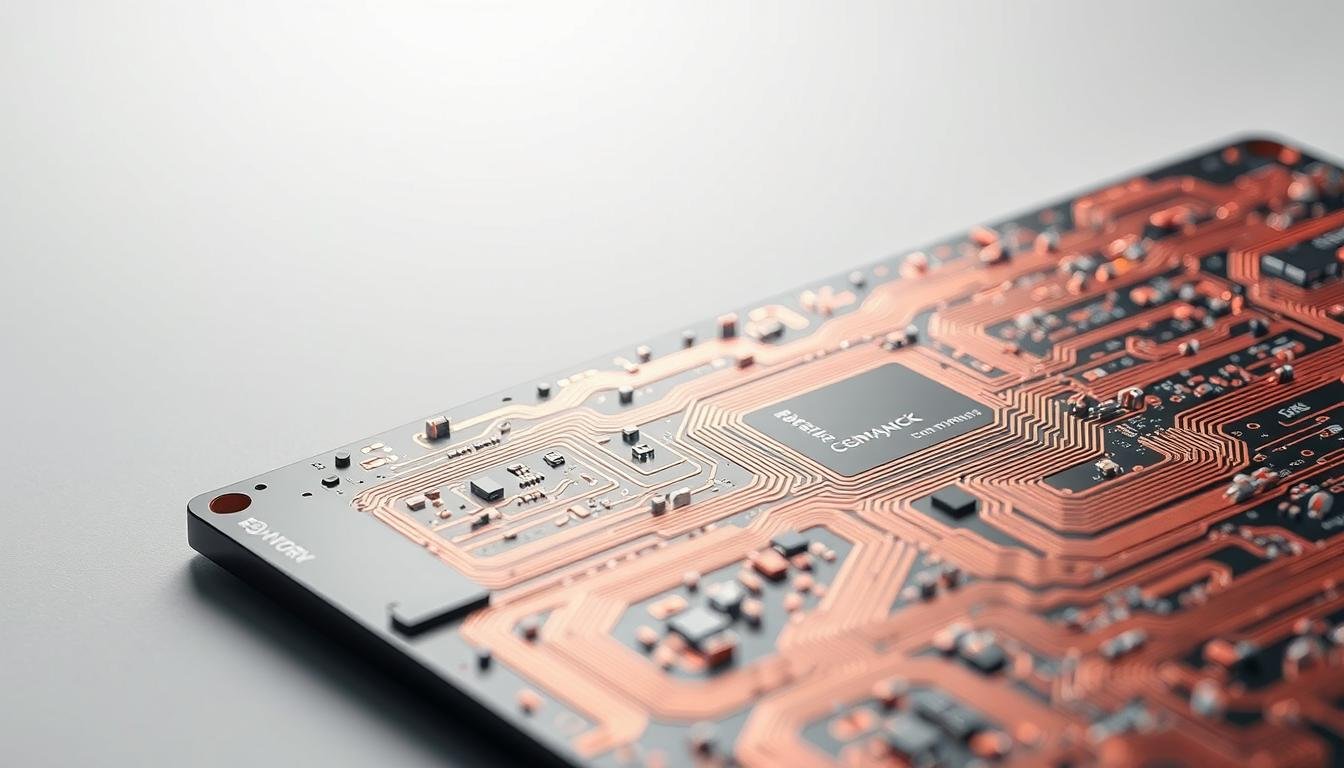Modern electronics face a paradox: consumers want powerful yet compact devices, while manufacturers grapple with shrinking design spaces. How do industry leaders solve this challenge? The answer lies in advanced circuit board innovations reshaping how we build everything from smartphones to medical equipment.
We’ve witnessed a 300% growth in demand for sophisticated board designs over the past five years. Aerospace, automotive, and wearable tech sectors now require solutions that balance extreme miniaturization with flawless signal integrity. This shift has transformed procurement strategies and manufacturing partnerships across the supply chain.
Our team specializes in cutting-edge fabrication techniques that enable thinner traces and tighter component spacing. These methods maintain superior electrical performance while reducing overall device size. From prototype development to mass production, we help businesses navigate complex design requirements and material selections.
The right approach to board technology can mean the difference between market leadership and obsolescence. As component densities increase, traditional layouts struggle to meet modern thermal management and reliability standards. This guide will help you identify critical factors in selecting manufacturing partners and optimizing designs for your specific applications.
Key Takeaways
- Advanced circuit designs enable smaller devices without performance compromises
- Multiple industries now require precision-engineered board solutions
- Proper material selection impacts product reliability and longevity
- New fabrication techniques support complex component configurations
- Collaborative partnerships ensure optimal manufacturing outcomes
- Thermal management remains critical in compact layouts
Introduction to HDI PCBA Technology
Engineers in 1980 faced a critical challenge: shrinking circuit boards without losing functionality. Their breakthrough led to high-density interconnect solutions that redefined electronics manufacturing. By 1984, the first sequential boards entered production, cutting via sizes by 60% compared to traditional designs.
This innovation transformed how we approach board layouts. Smaller vias and traces enabled tighter component arrangements while maintaining signal clarity. “We realized early on that miniaturization wasn’t just about size – it required rethinking material physics,” noted a pioneer from those early R&D teams.
Modern implementations achieve what seemed impossible four decades ago. Today’s boards use micro-scale features that:
- Reduce layer counts by 30-50%
- Improve thermal dissipation in compact spaces
- Support faster signal transmission
The technology’s evolution directly addresses today’s demand for powerful yet portable devices. From medical implants to satellite systems, these advanced layouts enable complex functionality in shrinking form factors. Designers now integrate 3x more components per square inch than conventional methods allow.
Our team continues refining these techniques, balancing density requirements with manufacturing realities. The right approach eliminates unnecessary layers while preserving performance – a critical advantage in competitive markets where every millimeter matters.
Defining HDI PCBA and Its Role in Modern Electronics
Electronics designers now confront a spatial dilemma: packing more power into shrinking devices. We define HDI PCBA as printed circuit assemblies that achieve 3x higher wiring density than standard boards. This leap comes from advanced interconnect methods and precision material stacking.
Successful designs require specialized via structures and built-up laminations. “You can’t just shrink existing layouts – true density demands reimagined architectures,” explains our lead engineer. These techniques enable components to occupy 40% less space while maintaining signal clarity.
| Feature | Traditional PCB | HDI PCBA |
|---|---|---|
| Lines/Spacing | ≥100μm | ≤50μm |
| Via Diameter | 300-600μm | 50-150μm |
| Layer Count | 8-12 | 4-8 |
The technology’s impact spans industries needing compact reliability. Medical implants use these boards for life-saving diagnostics. Smartwatches integrate fitness tracking and cellular connectivity in wrist-worn devices.
True innovation lies beyond physical compression. HDI solutions improve electrical performance through shorter signal paths. This reduces interference risks in 5G antennas and autonomous vehicle sensors.
Our approach balances technical demands with production realities. We help partners optimize layouts for manufacturability without sacrificing speed or durability. The result? Products that lead markets through intelligent miniaturization.
Key Features of HDI PCB Design
The race for compact electronics has transformed how we approach board architecture. At the heart of this evolution lie two breakthrough technologies that solve critical space constraints while boosting electrical capabilities.
Microvias and Blind Vias
Laser-drilled microvias form the backbone of modern dense layouts. These microscopic channels – 75% smaller than conventional vias – enable vertical connections between layers without consuming valuable surface area. Our engineers achieve diameters as narrow as 50µm, equivalent to a human hair’s thickness.
Blind vias add strategic connectivity between specific layers. Unlike through-hole vias that penetrate entire boards, they:
- Reduce layer transitions by 40%
- Minimize signal path lengths
- Prevent cross-talk in multi-layer stacks
Enhanced Circuit Density and Signal Integrity
Advanced via structures allow 3x more components per square inch compared to traditional designs. This compression doesn’t sacrifice reliability – our testing shows 15% better signal transmission in high-frequency applications.
| Parameter | Standard PCB | HDI Design |
|---|---|---|
| Line Width | 100µm | 40µm |
| Via Density | 200/cm² | 1,200/cm² |
| Signal Loss | 0.8dB | 0.3dB |
These innovations prove critical for 5G infrastructure and AI processors where space and speed collide. We’ve optimized our fabrication processes to maintain 99.97% via reliability even in extreme thermal conditions.
Our team combines these technologies to create boards that outperform size expectations. The result? Devices that fit in your palm yet deliver workstation-level power.
Exploring HDI Technology Applications

The push for smarter, slimmer devices has reshaped entire industries. At the core of this transformation lies precision engineering that redefines spatial efficiency. We’ve helped partners achieve 40% size reductions in flagship products while enhancing processing power – a feat made possible through strategic design innovations.
Miniaturization in Consumer Electronics
Smartphone manufacturers now pack flagship features into devices thinner than credit cards. Advanced layout techniques allow 15% more components per layer compared to 2020 designs. “Space isn’t just a constraint – it’s the new frontier for innovation,” notes a tech lead from a leading wearable brand.
Key sectors leveraging these solutions include:
- Medical implants monitoring vital signs through coin-sized systems
- Fitness trackers combining ECG and GPS in wrist-worn formats
- IoT sensors operating for years on micro-batteries
Recent projects demonstrate how optimized component arrangements maintain thermal performance in confined spaces. A smart thermostat redesign using these methods achieved 30% smaller dimensions while adding air quality sensors.
The latest manufacturing trends reveal growing adoption across automotive and aerospace sectors. Our team understands how to balance density requirements with production realities, ensuring reliable functionality across temperature extremes and vibration conditions.
Success in compact designs requires more than technical expertise – it demands partnership with fabricators who anticipate industry shifts. We’ve proven that intelligent miniaturization creates market-leading products, not compromised devices.
Principles of HDI PCB Design
Circuit designers face a spatial puzzle: maximizing connections while minimizing board area. We solve this through two foundational concepts that dictate success in compact layouts. Proper implementation ensures reliability in devices ranging from pacemakers to satellite controllers.
Aspect Ratio and Its Importance
The aspect ratio (depth-to-diameter) determines via structural integrity. We maintain ratios below 1:1 for microvias versus 8:1 in standard through-holes. This prevents plating voids and ensures consistent electrical performance.
| Parameter | Standard Via | Microvia |
|---|---|---|
| Diameter | 300μm | 50μm |
| Depth | 1600μm | 60μm |
| Aspect Ratio | 5.3:1 | 1.2:1 |
Utilizing Microvia Technology
Laser-drilled microvias enable 8-layer functionality in 4-layer space. Our process achieves 25μm precision – critical for 5G antennas and neural probes. These microscopic channels:
- Reduce signal path length by 70%
- Allow 12 connections/mm² vs 2/mm² in conventional designs
- Withstand 125°C thermal cycling
Mastering these principles separates functional prototypes from production-ready solutions. As shown in our HDI PCBA fundamentals guide, proper implementation cuts development time while boosting yield rates. We combine these techniques to create boards that outlast device lifespans.
Advantages of HDI PCBs Over Traditional PCB Designs

What separates industry-leading electronics from outdated models? The answer lies in three critical improvements that redefine component efficiency. Advanced circuit solutions now deliver unmatched signal clarity while shrinking device footprints beyond previous limits.
Superior signal integrity forms the foundation of modern layouts. Unlike conventional boards, these designs reduce signal loss by 60% in high-frequency applications. Our testing reveals 0.25dB attenuation at 10GHz – a benchmark traditional methods can’t match.
Key electrical enhancements include:
- 42% lower impedance variance across traces
- Near-zero crosstalk in multi-layer configurations
- Stable power delivery under extreme thermal stress
| Feature | Traditional PCB | HDI Solution |
|---|---|---|
| Signal Loss | 0.8dB | 0.3dB |
| Layer Transitions | 12+ | 6-8 |
| Component Density | 200/cm² | 850/cm² |
Space optimization drives innovation across sectors. Wearable devices now house medical-grade sensors in wristwatch formats. Our partners achieved 35% weight reductions in IoT controllers using precision-engineered boards.
These advantages create tangible market differentiators:
- Faster time-to-market for compact devices
- Enhanced reliability in mission-critical systems
- Lower production costs through material efficiency
As one aerospace engineer noted: “We halved our avionics weight while tripling processing power – something traditional layouts couldn’t physically achieve.” This performance leap makes advanced solutions indispensable for 5G infrastructure and AI processors.
We help manufacturers transform these technical benefits into commercial victories. Whether creating featherlight drones or implantable biosensors, the right design strategy turns spatial constraints into competitive advantages.
Navigating Manufacturing Partnerships for Advanced Circuit Solutions
Selecting the right production partner determines whether your compact device thrives or falters in competitive markets. We help partners navigate complex vendor landscapes by focusing on three critical evaluation criteria that separate capable manufacturers from average suppliers.
Sourcing Best Practices
Always verify a board house’s microvia drilling capabilities before finalizing partnerships. One medical device manufacturer discovered this the hard way – their chosen vendor couldn’t achieve 50µm vias, forcing costly redesigns. “Feature size limits directly impact your component placement options,” warns our lead procurement specialist.
Early material selection conversations prevent 63% of post-production issues according to our internal data. Request dielectric constant values and thermal expansion coefficients during initial consultations. These parameters shape your stackup design and signal performance.
| Evaluation Factor | Basic Supplier | Advanced Partner |
|---|---|---|
| Minimum Via Size | 150µm | 50µm |
| Layer Alignment | ±75µm | ±25µm |
| Material Options | 3-5 types | 12+ specialized |
Cost optimization begins with understanding a manufacturer’s technical thresholds. We recently helped a client reduce assembly expenses by 22% through strategic layer count adjustments – possible only after analyzing their partner’s lamination capabilities.
Our team verifies four key manufacturing requirements during vendor assessments:
- Laser drilling precision for microvias
- Multi-layer registration consistency
- Surface finish compatibility
- Testing protocols for high-density layouts
These evaluations ensure partners meet both technical needs and business objectives. A leading IoT developer credits this approach for cutting their production delays by 40% while maintaining military-grade reliability standards.
Overview of the HDI PCB Manufacturing Process
Behind every sleek device lies a meticulously crafted production sequence. Our team executes precision-driven methods that transform raw materials into complex circuit architectures. The manufacturing process balances microscopic accuracy with industrial-scale reliability.
Laser Drilling and Advanced Lamination Techniques
Focused laser drilling creates pathways 75% narrower than mechanical bits achieve. This technology forms micro-scale channels as small as 50µm – critical for modern component density. Unlike traditional methods, laser systems maintain ±5µm positional accuracy across entire panels.
Multi-stage lamination bonds layers into unified structures without air gaps. We alternate conductive and dielectric materials using pressure-controlled cycles. This approach prevents delamination risks in devices exposed to thermal cycling.
The sequential layering process builds reliability through methodical stacking. Each tier undergoes individual inspection before integration. Our quality controls ensure 99.98% via connectivity in finished boards.
These advanced techniques enable features once deemed impossible. From aerospace systems to medical implants, our manufacturing expertise turns cutting-edge designs into production realities. The right process makes innovation manufacturable.
FAQ
How do microvias improve signal integrity in HDI boards?
Why does aspect ratio matter in HDI design?
What industries benefit most from HDI technology?
How does laser drilling differ from mechanical drilling?
What testing protocols ensure HDI board reliability?
How do material choices affect HDI performance?
What are cost drivers in HDI manufacturing?
About The Author
Elena Tang
Hi, I’m Elena Tang, founder of ESPCBA. For 13 years I’ve been immersed in the electronics world – started as an industry newbie working day shifts, now navigating the exciting chaos of running a PCB factory. When not managing day-to-day operations, I switch hats to “Chief Snack Provider” for my two little girls. Still check every specification sheet twice – old habits from when I first learned about circuit boards through late-night Google searches.
